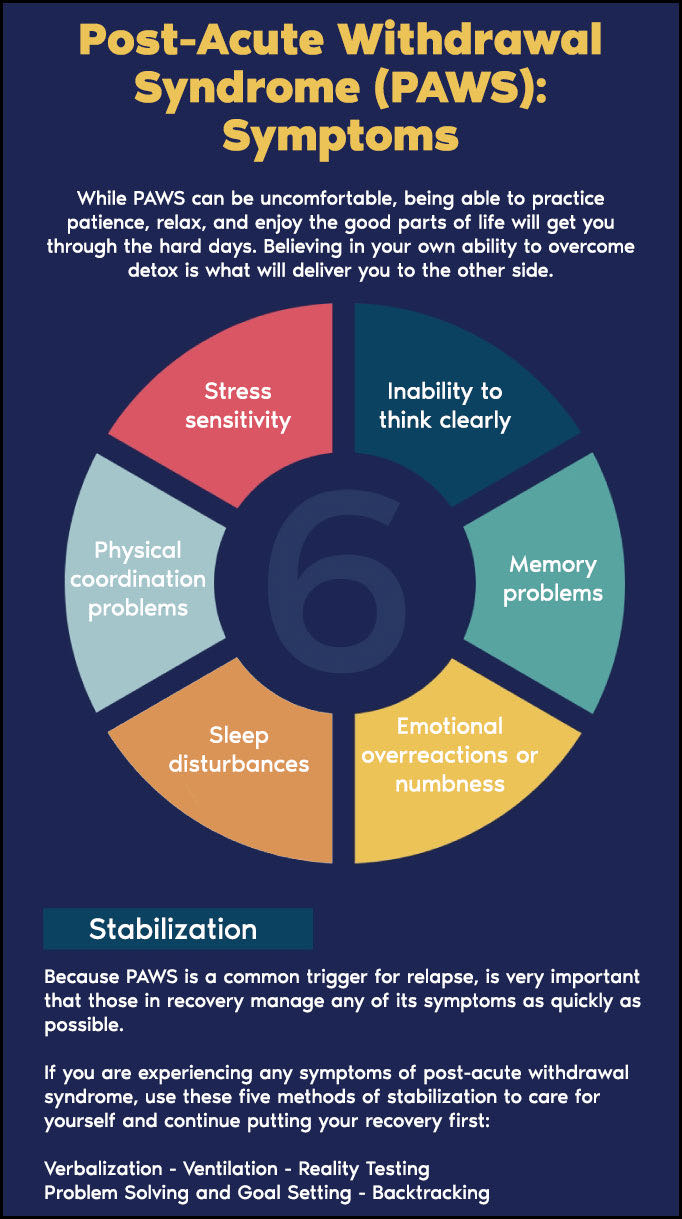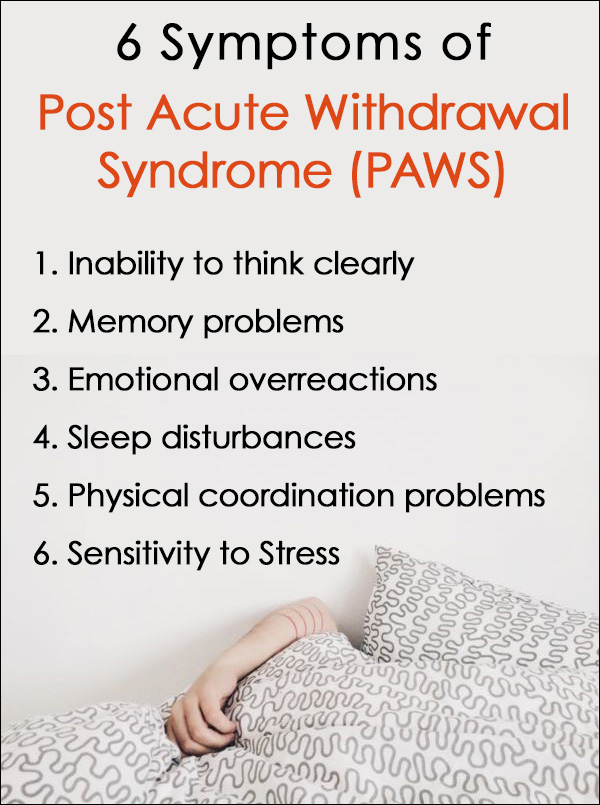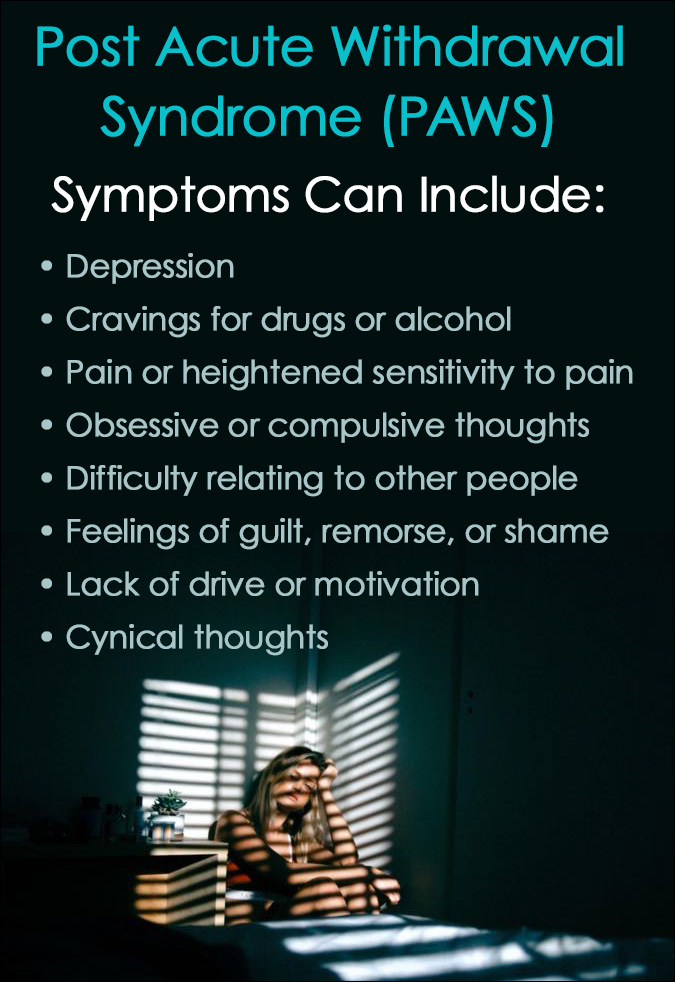
Post Acute Withdrawal Syndrome (PAWS) is not a term most people are familiar with, although many in recovery know about the symptoms.
It’s common for people with a substance use addiction to fear detox and withdrawal because of the uncomfortable physical and mental symptoms.
The cravings, pain, and flu-like symptoms are a few of the biggest reasons some individuals continue using drugs or alcohol instead of quitting or going to treatment.
These symptoms occur during the first stage of drug and alcohol detox, commonly known as “acute withdrawal.”
But in reality, withdrawal symptoms do not always end the moment the addictive substance is no longer present in a person’s system.
In fact, it can take up to two years for the brain’s neurochemistry to return to normal depending on the substance and others factors due to a condition known as Post Acute Withdrawal Syndrome.
What is Post Acute Withdrawal Syndrome?
Post-Acute Withdrawal Syndrome (PAWS) is the second stage that takes place after acute withdrawal ends and it comes with its own problematic symptoms.
It is sometimes called prolonged withdrawal syndrome, or protracted withdrawal syndrome, but whatever the name, PAWS symptoms are much less pleasant than its cute acronym would lead you to believe.
The unfortunate reality of Post Acute Withdrawal Syndrome is that the symptoms can be a trigger for relapse. Because this second stage of withdrawal occurs during the period in which the brain chemistry is returning to normal, it can take 20 months or more before it has passed.
Often times, people going through benzodiazepine withdrawal will notice the longest period of symptoms that could last for a year or more.
Withdrawal from opioids and PAWS alcohol symptoms can be less persistent than benzos, but could still be long-lasting and may be marked by bouts of depression or anxiety. In severe cases, patients may experience delirium tremens.
The most important thing people in recovery need to understand is that recovery takes time. If a person goes into detox expecting it to be over within a matter of days, they are far more likely to be unprepared for the journey ahead.

Symptoms of Post Acute Withdrawal Syndrome
There is a wide range of Post Acute Withdrawal Syndrome symptoms that typically accompany this phase of recovery, such as anhedonia symptoms or the inability to feel pleasure.
It is essential that anyone going through the post acute withdrawal stage makes self-care a priority during recovery.
While PAWS symptoms can be uncomfortable, being able to have patience, relax, and enjoy the good parts of life to make it through the difficult days.
Believing in the ability to overcome paws symptoms in time is crucial to staying on track and preventing a relapse.
6 Common Post Acute Withdrawal Syndrome Symptoms
- Inability to think clearly
- Memory problems
- Emotional overreactions or numbness
- Sleep disturbances
- Physical coordination problems
- Sensitivity to Stress
1. Inability to Think Clearly
The mental confusion or inability to think clearly when experiencing PAWS symptoms should not be confused with overall intelligence. Think of this symptom as a malfunction that switches on and off, rather than a chronic condition.
Unclear thinking can include the inability to concentrate for long periods of time and the impairment of abstract reasoning, meaning it inhibits the ability to identify logical rules and apply them to basic problem solving.
Another similar symptom is rigid and repetitive thinking in which the same thoughts circle around until they cannot be put together in an orderly way.
2. Memory Problems
Imagine being able to understand something when it is first explained, but 20 minutes later, you either can’t make sense of it or have forgotten it completely. This is a common and particularly frustrating symptom that accompanies PAWS syndrome.
In addition, long term memory can be affected, and those experiencing Post Acute Withdrawal Syndrome may have a difficult time remembering significant events from the past. Much like how the ability to think clearly comes and goes, memory can also come and go in the same manner.
Something that is easily remembered in one moment may be lost in the next, making it especially difficult to retain new information or learn new skills.
3. Emotional Overreaction or Numbness
We all know someone who has a tendency to overreact – a person whose response to stress or excitement is consistently more amplified than it should be.
Now, imagine that person’s typical reaction multiplied by ten. This is the emotional overreaction response associated with post-acute withdrawal syndrome.
When experiencing PAWS symptoms, even the most trivial matters can lead to intense anger or anxiety, a response that has the potential to overwhelm the nervous system, resulting in an emotional shutdown.
When this occurs, it leaves a person feeling numb and with unpredictable mood swings.

4. Sleep Problems
While the majority of PAWS symptoms are temporary, issues related to sleep may be lifelong. This symptom often manifests in unusual or disturbing dreams that may interfere with full, restful sleep, as well as a difficulty falling asleep or staying asleep for the entire night.
These issues can result in a change to sleep patterns, meaning a person will sleep for unusually long periods of time, or at odd times of the day. Even though sleep issues are likely to improve with time, some of the abnormal patterns may never be resolved completely.
Fortunately, this is a symptom that many become accustomed to without severe difficulty.
5. Physical Coordination Problems
A less common but particularly challenging symptom of Post Acute Withdrawal Syndrome is a difficulty with physical coordination, making a person more prone to injuries and accidents.
This can result in stumbling or clumsiness that makes a sober person appear to be intoxicated.
This symptom is marked by dizziness, imbalance, poor hand-eye coordination, and slow reflexes.
6. Sensitivity to Stress
For those without PAWS syndrome, distinguishing between low-stress and high-stress situations comes naturally. However, not having this ability can easily lead to emotional breakdowns related to compounded stress or intense overreactions that result in inappropriate behavior.
While a person experiencing PAWS may act irrationally to stress in the moment, later on they will often be able to see the situation more clearly. This can lead to confusion and aggravation, as even they won’t understand why they reacted so strongly.

Additional Post-Acute Withdrawal Symptoms
The six symptoms listed above are the most common ones that people experience during the post-acute withdrawal stage, but each person is different and so is each type of addiction.
Other PAWS Symptoms Include:
- Depression
- Cravings for drugs or alcohol
- Pain or a heightened sensitivity to pain
- Obsessive or compulsive thoughts, similar to OCD
- Difficulty relating to other people
- Feelings of guilt, remorse, or shame
- Lack of drive or motivation
- Cynical thoughts
Many of these may come and go over time, so it’s essential to recognize these are only symptoms of withdrawal and usually won’t last for long. This makes it necessary to find ways to overcome or learn how to stabilize them.
Stabilization of Post-Acute Withdrawal Syndrome Symptoms
Because Post Acute Withdrawal Syndrome issues can trigger a relapse, it is very important that those in recovery manage any of its symptoms as quickly as possible.
For people in recovery who are experiencing any of the signs of post-acute withdrawal syndrome, it’s necessary to stabilize the symptoms with appropriate self-care tips and to continue putting recovery first without worrying about relapse.
5 Ways to Stabilize Post-Acute Withdrawal Syndrome Symptoms
1. Verbalization
Verbalizing your thoughts and feelings can be difficult at first, but it can be an indispensable part of recovery.
Having people to talk to who will not criticize or minimize what you are experiencing is crucial. Not only will it provide support, it will also give you the opportunity to bring conscious awareness to your symptoms and help you see your situation realistically.
2. Venting
Learn to express how you are thinking and feeling, regardless of whether it seems irrational or unfounded. We all need to vent at some point but make it productive. Once you let it out, be done with it and move on without looking back.
3. Reality Testing
Your perception of what is going on may be very different from reality. It is meaningful to ask those around you if what you are saying and how you are acting is making sense.
This circles back to verbalization and points to why it’s critical to have a good support system of people you can count on to be honest and objective without being critical of your situation.
4. Problem Solving and Goal Setting
Be proactive about getting better. Identify steps you can take to continue moving forward and create a plan of what you can do to get there.
Having goals will ensure that you are staying on track and this makes it easier to measure your progress. If you stray from the goals you set or fall back, recognize this and make changes to resume the coarse. This is why problem solving is grouped with goal setting.
5. Backtracking
Reflect on the symptoms you have experienced. Make note of when they began and reflect on what you can do to turn them off. Recall specific symptomatic episodes and analyze what may have caused them and what helped resolve them.
Identify actions you can take to help prevent future episodes or end them more quickly.
Treatment for PAWS Syndrome
To minimize the symptoms of post-acute withdrawal syndrome, it’s critical to begin recovery at a medically-supervised detox facility that is staffed by trained professionals to monitor all the symptoms and keep the patient comfortable.
A Medication Assisted Treatment Program can be beneficial for overcoming many of the withdrawal symptoms and reducing cravings during detox and after it is finished.
After detox has been completed, transitioning to a residential addiction treatment program will offer the most effective way of recovering and staying on track to reduce the chances of relapse.
An inpatient program will also offer therapies and tools to alleviate many of the psychological symptoms of withdrawal.
Regular exercise, a healthy diet, and proper, restful sleep each night are excellent ways to improve mood and counteract the negative side effects of post-acute withdrawal.
Cognitive Behavioral Therapy is recommended as a way to understand and mitigate the signs of negative thinking that can accompany PAWS.
As mentioned earlier, recovery takes time. Having a good support system in place, especially in the early stages, is crucial for a successful recovery.
Related Posts
- Cocaine Withdrawal Symptoms, Treatment and Detox
Giving up a stimulant substance like cocaine has a complex psychological effect on the recovering…
- Fetal Alcohol Syndrome - What is It and What are the Symptoms?
Did you know that Fetal Alcohol Syndrome (FAS) is the leading cause of preventable birth…
- High-Functioning Anxiety Symptoms and Treatment
Anxiety disorders are the most common form of mental illness in the United States. They…
